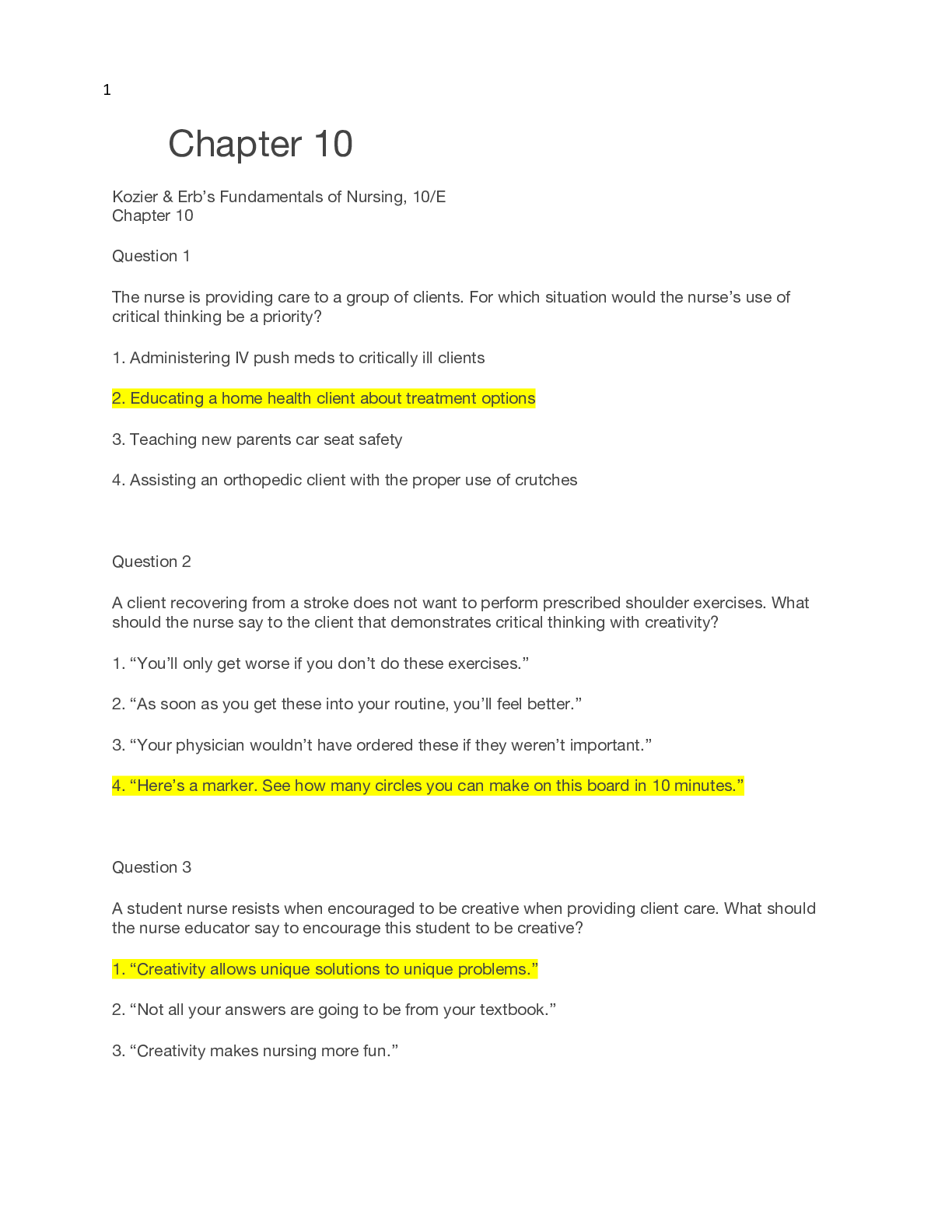*NURSING > TEST BANK > Nursing Test Banks Pain Management Potter et al.: Fundamentals of Nursing, 9th Edition,100% CORRECT (All)
Nursing Test Banks Pain Management Potter et al.: Fundamentals of Nursing, 9th Edition,100% CORRECT
Document Content and Description Below
Nursing Test Banks Pain Management Potter et al.: Fundamentals of Nursing, 9th Edition One Account Get all Test Banks Chapter 44: Pain Management MULTIPLE CHOICE 1.An oriented patient has recent... ly had surgery. Which action is best for the nurse to take to assess this pa- tient’s pain? a. Assess the patient’s body language. b. Ask the patient to rate the level of pain. c. Observe the cardiac monitor for increased heart rate. d. Have the patient describe the effect of pain on the ability to cope. ANS: B One of the most subjective and therefore most useful characteristics for reporting pain is its severity. There- fore, the best way to assess a patient’s pain is to ask the patient to rate the pain. Nonverbal communication, such as body language, is not as effective in assessing pain, especially when the patient is oriented. Heart rate sometimes increases when a patient is in pain, but this is not a symptom that is specific to pain. Pain some- times affects a patient’s ability to cope, but assessing the effect of pain on coping assesses the patient’s ability to cope; it does not assess the patient’s pain. DIF:Apply (application)REF:1025 OBJ:Assess a patient experiencing pain.TOP:Assessment MSC: Physiological Adaptation 2.A nurse is caring for a patient who recently had abdominal surgery and is experiencing severe pain. The pa- tient’s blood pressure is 110/60 mm Hg, and heart rate is 60 beats/min. Additionally, the patient does not ap- pear to be in any distress. Which response by the nurse is most therapeutic? a. “Your vitals do not show that you are having pain; can you describe your pain?” b. “OK, I will go get you some narcotic pain relievers immediately.” c. “What would you like to try to alleviate your pain?” d. “You do not look like you are in pain.” ANS: C Be sure the patient is a partner in making decisions about the best approaches for managing pain. A patient knows the most about his or her pain and is an important partner in selecting successful pain therapies. The nurse must believe that a patient is in pain whenever the patient reports that he or she is in pain, even if the patient does not appear to be in pain. The nurse must be careful to not judge the patient based on vital signs or nonverbal communication and must not assume that the patient is seeking narcotics. The patient is a part- ner in pain management, so going to get narcotics to treat the pain without consulting with the patient first is not appropriate. DIF:Apply (application)REF:1022 | 1029 OBJ: Describe guidelines for selecting and individualizing pain therapies. TOP:Communication and Documentation MSC: Physiological Adaptation 3.A nurse teaches the patient about the gate control theory. Which statement made by a patient reflects a cor- rect understanding about the relationship between the gate control theory of pain and the use of meditation to relieve pain? a. “Meditation controls pain by blocking pain impulses from coming through the gate.” b. “Meditation alters the chemical composition of pain neuroregulators, which closes the gate.” c. “Meditation will help me sleep through the pain because it opens the gate.” d. “Meditation stops the occurrence of pain stimuli.” ANS: A According to this theory, gating mechanisms located along the central nervous system regulate or block pain impulses. Pain impulses pass through when a gate is open and are blocked when a gate is closed. Nonpharma- cologic pain-relief measures, such as meditation, work by closing the gates, which keeps pain impulses from coming through. Meditation does not open pain gates or stop pain from occurring. Meditation also does not have an effect on pain neuroregulators. DIF:Apply (application)REF:1016 OBJ escribe the physiology of pain.TOP:Teaching/Learning MSC: Physiological Adaptation 4.A nurse is planning care for an older-adult patient who is experiencing pain. Which statement made by the nurse indicates the supervising nurse needs to follow up? a. “As adults age, their ability to perceive pain decreases.” b. “Older patients may have low serum albumin in their blood, causing toxic effects of analgesic drugs.” c. “Patients who have dementia probably experience pain, and their pain is not always well controlled.” d. “It is safe to administer opioids to older adults as long as you start with small doses and frequently assess the pa- tient’s response to the medication.” ANS: A Aging does not affect the ability to perceive pain. This misconception must be corrected by the supervising nurse. All the other statements are true and require no follow-up. Opioids are safe to use in older adults as long as they are slowly titrated and the nurse frequently monitors the patient. Patients with dementia most likely experience unrelieved pain because their pain is difficult to assess. Older adults frequently eat poorly, re- sulting in low serum albumin levels. Many drugs are highly protein bound. In the presence of low serum albu- min, more free drug (active form) is available, thus increasing the risk for side and/or toxic effects. DIF:Apply (application)REF:1019 OBJ iscuss common misconceptions about pain. TOP:Teaching/LearningMSC:Management of Care 5. The nurse is caring for two patients; both are having a hysterectomy. The first patient is having the hysterec- tomy after a complicated birth. The second patient has uterine cancer. What will most likely influence the ex- perience of pain for these two patients? a. Meaning of pain b. Neurological factors c. Competency of the surgeon d. Postoperative support personnel ANS: A The degree and quality of pain perceived by a patient are related to the meaning of the pain. The patient’s per- ception of pain is influenced by psychological factors, such as anxiety and coping, which in turn influence the patient’s experience of pain. Each patient’s experience is different. Neurological factors can interrupt or influ- ence pain perception, but neither of these patients is experiencing alterations in neurological function. The knowledge, attitudes, and beliefs of nurses, health care providers, the surgeon, and other health care person- nel about pain affect pain management but do not necessarily influence a patient’s pain perceptions. DIF:Apply (application)REF:1021 OBJ: Identify components of the pain experience. TOP: Assessment MSC sychosocial Integrity 6. The nurse is preparing pain medications. To which patient does the nurse anticipate administering an opioid fentanyl patch? a. A 15-year-old adolescent with a fractured femur b. A 30-year-old adult with cellulitis c. A 50-year-old patient with prostate cancer d. An 80-year-old patient with a broken hip ANS: C Transdermal fentanyl (patch), which is 100 times more potent than morphine, is available for opioid-tolerant patients with cancer or chronic pain (prostate cancer). It delivers predetermined doses that provide analgesia for up to 72 hours. The other patients are expected to experience acute pain (fractured femur, cellulitis, and broken hip). Therefore, they will most likely benefit from oral or IV opioids for short-term pain relief. DIF:Apply (application)REF:1042 OBJ:Explain various pharmacological approaches to treating pain. TOP lanningMSC harmacological and Parenteral Therapies 7.A patient is receiving opioid medication through an epidural infusion. Which action will the nurse take? a. Restrict fluid intake. b. Label the tubing that leads to the epidural catheter. c. Apply a gauze dressing to the epidural catheter insertion site. d. Ask the nursing assistive personnel to check on the patient at least once every 2 hours. ANS: B To reduce the accidental administration of IV medications into the epidural catheter, the tubing that leads to the epidural catheter needs to be labeled clearly. The epidural insertion site needs to be covered by a transpar- ent dressing to prevent infection and allow the nurse to assess the site. Patients receiving epidural anesthesia need to be monitored every 15 minutes until stabilized and then at least hourly for 12 to 24 hours. DIF:Apply (application)REF:1040 OBJ iscuss nursing implications for administering analgesics. TOP: Implementation MSC: Reduction of Risk Potential 8.A woman is in labor and refuses to receive any sort of anesthesia medication. Which alternative treatment is best for this patient? a. Transcutaneous electrical nerve stimulation (TENS) b. Herbal supplements with analgesic effects c. Pudendal block (regional anesthesia) d. Relaxation and guided imagery ANS: D In the case of a patient in labor, relaxation with guided imagery is often an effective supplement for pain man- agement because it provides women with a sense of control over their pain. Relaxation and guided imagery can be used during any phase of health or illness. TENS units are typically used to manage postsurgical and procedural pain. Herbal supplements need to be evaluated for safety during pregnancy. Additionally, some pa- tients consider herbal supplements to be another form of medication, and they are not typically used to con- trol acute pain. A pudendal block is a type of regional anesthesia (injection or infusion of local anesthetics to block a group of sensory nerve fibers); use of it does not respect the patient’s wishes for nonpharmacological pain control. DIF:Analyze (analysis)REF:1032-1033 OBJ: Describe applications for use of nonpharmacological pain interventions. TOP: Implementation MSC: Basic Care and Comfort 9.A nurse is teaching a patient about patient-controlled analgesia (PCA). Which statement made by the patient indicates to the nurse that teaching is effective? a. “I will only need to be on this pain medication.” b. “I feel less anxiety about the possibility of overdosing.” c. “I can receive the pain medication as frequently as I need to.” d. “I need the nurse to notify me when it is time for another dose.” ANS: B A PCA is a device that allows the patient to determine the level of pain relief delivered, reducing the risk of over- dose. The PCA infusion pumps are designed to deliver a specific dose that is programmed to be available at specific time intervals (usually in the range of 8 to 15 minutes) when the patient activates the delivery button. A limit on the number of doses per hour or 4-hour interval may also be set. This can help decrease a patient’s anxiety related to possible overdose. Its use also often eases anxiety because the patient is not reliant on the nurse for pain relief. Other medications, such as oral analgesics, can be given in addition to the PCA machine. One benefit of PCA is that the patient does not need to rely on the nurse to administer pain medication; the patient determines when to take the medication. DIF:Analyze (analysis)REF:1038 OBJ:Explain various pharmacological approaches to treating pain. TOP: Teaching/Learning MSC: Reduction of Risk Potential 10.A nurse is caring for a patient who is experiencing pain following abdominal surgery. Which information is important for the nurse to share with the patient when providing patient education about effective pain management? a. “To prevent overdose, you need to wait to ask for pain medication until you begin to experience pain.” b. “You should take your medication after you walk to make sure you do not fall while you are walking.” c. “We should work together to create a schedule to provide regular dosing of medication.” d. “When you experience severe pain, you will need to take oral pain medications.” ANS: C One way to maximize pain relief while potentially decreasing opioid use is to administer analgesics around the clock (ATC) rather than on a prn basis. This approach ensures a more constant therapeutic blood level of an analgesic. Working with the patient to design a schedule allows the patient to be a full partner in the care pro- vided. The nurse should not wait until pain is experienced because it takes medications 10-30 minutes to begin to relieve pain. The nurse administers pain medications before painful activities, such as walking, and adminis- ters intravenous medications when a patient is having severe pain. DIF:Apply (application)REF:1024 | 1036 OBJ iscuss nursing implications for administering analgesics. TOP lanningMSC harmacological and Parenteral Therapies 11.A nurse is caring for a patient who recently had spinal surgery. The nurse knows that patients usually experi- ence acute pain following this type of surgery. The patient refuses to get up and walk and is not moving around in the bed. However, the patient is stoic and denies experiencing pain at this time. What most likely explains this patient’s behavior? a. The surgery successfully cured the patient’s pain. b. The patient’s culture is possibly influencing the patient’s experience of pain. c. The primary health care provider did not prescribe the correct amount of medication. d. The nurse is allowing personal beliefs about pain to influence pain management at this time. ANS: B A patient’s culture or beliefs about pain often influence the patient’s expression of pain. In this case, the patient has just had surgery, and the nurse knows that this surgical procedure usually causes patients to experience pain. It is important at this time for the nurse to examine cultural and ethnic factors that are possibly affecting the patient’s lack of expression of pain at this time. Even if surgery corrects neurological factors that create chronic pain, surgery causes pain in the acute period. The patient has not taken any pain medication so this is an unrealistic assumption; most pain medications have standard dosages. The nurse is not allowing personal beliefs to influence pain management because the nurse is attempting to determine the reason why the pa- tient is not verbalizing the experience of pain. DIF:Apply (application)REF:1021-1022 OBJ:Explain how cultural factors influence the pain experience. TOP: Assessment MSC: Basic Care and Comfort 12.A nurse is providing discharge teaching for a patient with a fractured humerus. The patient is going home with hydrocodone. Which important patient education does the nurse provide? a. “You need to drink plenty of fluids and eat a diet high in fiber.” b. “Narcotics can be addictive, so do not take them unless you are in severe pain.” c. “Be sure to eat a meal high in fat before taking the medication, to avoid a stomach ulcer.” d. “As your pain severity lessens, you will begin to give yourself once-daily intramuscular injections.” ANS: A A common side effect of opioid analgesics is constipation. Therefore, the nurse encourages the patient to drink fluids and eat fiber to prevent constipation. Although medications can be irritating to the stomach, eating a diet high in fat does not prevent gastric ulcers. To best manage pain, the patient needs to take pain medication be- fore painful procedures or activities or before pain becomes severe. As the patient’s pain gets better, the strength of the medications will decrease. IM, IV, and topical analgesics are used for more severe and chronic pain. DIF:Apply (application)REF:1035-1036 OBJ iscuss nursing implications for administering analgesics. TOP:Teaching/Learning MSC harmacological and Parenteral Therapies 13.A patient arrives at the emergency department experiencing a headache and rates the pain as 7 on a 0 to 10 pain scale. Which nonpharmacological intervention does the nurse implement for this patient while awaiting orders for pain medication from the health care provider? a. Reassures the patient that the provider will come to the emergency department soon b. Softly plays music that the patient finds relaxing c. Frequently reassesses the patient’s pain scores d. Teaches the patient how to do yoga ANS: B The appropriate nonpharmacological pain-management intervention is to quietly play music that the patient finds relaxing. Music diverts a person’s attention away from pain and creates relaxation. Reassessing the pa- tient’s pain scores is done during evaluation. Building the patient’s expectation of the provider’s arrival does not address the patient’s pain. Although yoga promotes relaxation, nurses teach relaxation techniques only when a patient is not experiencing acute pain. Because the patient is having acute pain, this is not an appropri- ate time to provide patient teaching. DIF:Apply (application)REF:1030 | 1033 OBJ: Describe applications for use of nonpharmacological pain interventions. TOP: Implementation MSC: Basic Care and Comfort 14.A patient who has had type 2 diabetes for 26 years is beginning to experience peripheral neuropathy in the feet and lower leg. The nurse is providing education to the patient to prevent injury to the feet by wearing shoes or slippers when walking. Which statement made by the nurse best explains the rationale for this instruction? a. “Wearing shoes blocks pain perception and helps you adapt to pain, which ends up protecting your feet.” b. “Shoes provide nonpharmacological pain relief to people with diabetes and peripheral neuropathy.” c. “The neurological gates open when wearing shoes, which protects your feet.” d. “If you step on something without shoes, you might not feel it; this could possibly cause injury to your foot.” ANS: D Any factor that interrupts or influences normal pain reception or perception (e.g., spinal cord injury, peripheral neuropathy, or neurological disease) affects a patient’s awareness of and response to pain. The patient will no longer have protective reflexes to prevent injury to the feet. Wearing shoes prevents the patient from injuring the feet because they protect the feet. Shoes do not block pain perception, and they do not help people adapt to pain. Shoes are not a form of nonpharmacological pain relief. Wearing shoes will not have an effect on open- ing or closing the pain gates. DIF:Understand (comprehension)REF:1021 OBJ escribe the physiology of pain.TOP:Teaching/Learning MSC: Safety and Infection Control 15.A nurse is assessing a patient who started to have severe pain 3 days ago. When the nurse asks the patient to describe the pain, the patient states, “The pain feels like it is in my stomach. It is a burning pain, and it spreads out in a circle around the spot where it hurts the most.” Which type of pain does the nurse document the patient is having at this time? a. Superficial pain b. Idiopathic pain c. Chronic pain d. Visceral pain ANS: D Visceral pain arises from visceral organs, such as those from the gastrointestinal tract. Visceral pain is diffuse and radiates in several directions and can have a burning quality. Superficial pain has a short duration and is usually a sharp pain arising from the skin. Pain of an unknown cause is called idiopathic pain. Chronic pain lasts longer than 6 months. DIF:Analyze (analysis)REF:1018 OBJ:Assess a patient experiencing pain.TOP:Assessment MSC: Physiological Adaptation 16.A patient who had a motor vehicle crash 2 days ago is experiencing pain and is receiving patient-controlled analgesia (PCA). Which assessment finding indicates effective pain management with the PCA? a. The patient is sleeping and is difficult to arouse. b. The patient rates pain at a level of 2 on a 0 to 10 scale. c. The patient has sufficient medication left in the PCA syringe. d. The patient presses the control button to deliver pain medication. ANS: B A level of 2 on a scale of 0 to 10 is evidence of effective pain management. The effectiveness of pain-relief mea- sures is determined by the patient. If the patient is satisfied with the amount of pain relief, then pain measures are effective. A patient who is sleeping and is difficult to arouse is possibly oversedated; the nurse needs to as- sess this patient further. The amount of medication left in the PCA syringe does not indicate whether pain management is effective or not. Pressing the button shows that the patient knows how to use the PCA but does not evaluate pain management. DIF:Apply (application)REF:1045 OBJ: Evaluate a patient’s response to pain interventions. TOP: Evaluation MSC harmacological and Parenteral Therapies 17. The nurse is caring for a patient to ease modifiable factors that contribute to pain. Which areas did the nurse focus on with this patient? a. Age and gender b. Anxiety and fear c. Culture and ethnicity d. Previous pain experiences and cognitive abilities ANS: B Some examples of modifiable contributors to pain are anxiety and fear. The nurse can take measures to ease the patient’s anxiety and fear related to pain. Age, gender, culture, ethnicity, cognitive abilities, and previous pain experience are all nonmodifiable factors that the nurse can help the patient to understand, but the nurse cannot alter them. DIF:Apply (application)REF:1021 OBJ: Identify components of the pain experience. TOP: Implementation MSC sychosocial Integrity 18. The nurse is evaluating the effectiveness of guided imagery for pain management as used for a patient who has second- and third-degree burns and needs extensive dressing changes. Which finding best indicates the effectiveness of guided imagery? a. The patient’s facial expressions are stoic during the procedure. b. The patient rates pain during the dressing change as a 6 on a scale of 0 to 10. c. The patient’s need for analgesic medication decreases during the dressing changes. d. The patient asks for pain medication during the dressing changes only once throughout the procedure. ANS: C If the patient needs less pain medication during dressing changes, then guided imagery is helping to manage the patient’s pain. The purpose of guided imagery is to allow the patient to alter the perception of pain. Guided imagery works in conjunction with analgesic medications, potentiating their effects. A rating of 6 on a 0 to 10 scale indicates that the patient is having moderate pain and shows that this patient is not experiencing pain re- lief at this time. A person who is stoic is not showing feelings, which makes it difficult to know whether or not the patient is experiencing pain. Having to ask for pain medication during the dressing changes indicates the guided imagery is not effective. DIF:Analyze (analysis)REF:1032 | 1045 OBJ: Evaluate a patient’s response to pain interventions. TOP: Evaluation MSC: Basic Care and Comfort 19.A nurse is providing medication education to a patient who just started taking ibuprofen. Which information will the nurse include in the teaching session? a. Ibuprofen helps to depress the central nervous system to decrease pain perception. b. Ibuprofen reduces anxiety, which will help you cope with your pain. c. Ibuprofen binds with opiate receptors to reduce your pain. d. Ibuprofen inhibits the production of prostaglandins. ANS: D NSAIDs like ibuprofen likely work by inhibiting the synthesis of prostaglandins to inhibit cellular responses to inflammation. Ibuprofen does not depress the central nervous system, nor does it enhance coping with pain. Opioids bind with opiate receptors to modify perceptions of pain. DIF:Understand (comprehension)REF:1035 OBJ: Explain how the physiology of pain relates to selecting interventions for pain relief. TOP:Teaching/Learning MSC harmacological and Parenteral Therapies 20. The nurse has brought a patient the scheduled pain medication. The patient asks the nurse to wait to give pain medication until the time for the dressing change, which is 2 hours away. Which response by the nurse is most therapeutic? a. “This medication will still be providing you relief at the time of your dressing change.” b. “OK, swallow this pain pill, and I will return in a minute to change your dressing.” c. “Would you like medication to be given for dressing changes in addition to your regularly scheduled medication?” d. “Your medication is scheduled for this time, and I can’t adjust the time for you. I’m sorry, but you must take your pill right now.” ANS: C Additional doses of medication can be given to patients in certain circumstances, as with an extensive dressing change, when the health care provider is notified that more medication is needed. It is the nurse’s responsibili- ty to communicate with the provider and with the patient about a pain-control plan that works for both. By ask- ing to hold off on the dose, the patient is indicating that the dressing changes are extremely painful. The regu- larly scheduled dose might not be as effective for the patient 2 hours later when the dressing change is sched- uled. Oral medications take 30 to 60 minutes to take effect. If the nurse began the dressing change right then, the medication would not have been absorbed yet. The patient has the right to refuse to take a medication. DIF:Apply (application)REF:1037 | 1045 OBJ:Explain various pharmacological approaches to treating pain. TOP:Communication and Documentation MSC:Management of Care 21.A nurse receives an order from a health care provider to administer hydrocodone and acetaminophen (Vi- codin ES 7.5/750), to a patient who is experiencing 8/10 postsurgical pain. The order is to give 2 tablets every 6 hours by mouth as needed for pain. What is the nurse’s next best action? a. Give the Vicodin ES to the patient immediately because the patient is experiencing severe pain. b. Ask the health care provider for a nonsteroidal antiinflammatory drug (NSAID) order. c. Ask the health care provider to verify the dosage and frequency of the medication. d. Give the Vicodin ES in addition to playing soothing music for the patient. ANS: C The maximum 24-hour dosage for acetaminophen is 4 grams. If the patient took 2 tablets of Vicodin ES every 6 hours, the patient would take in 6 grams of acetaminophen in 24 hours (2 tablets = 750 + 750 = 1500 4 [could have 4 doses in 24 hours every 6 hours] = 6000 mg = 6 g). This exceeds the safe dosage of acetaminophen, so the best action is to question this order. Giving the medication as ordered would possibly result in the patient’s taking more acetaminophen than is considered a safe dose. Acetaminophen overdose can result in liver failure. NSAIDs are used to treat mild to moderate pain. At this moment, the patient is experiencing severe pain. Imple- menting music therapy is a nursing intervention and is an independent nursing action that can be instituted with pain medication, but the possible acetaminophen dose is the priority. DIF:Analyze (analysis)REF:1035 | 1037 OBJ iscuss nursing implications for administering analgesics. TOP:ImplementationMSC:Management of Care 22.The nurse is caring for a 4-year-old child who has pain. Which technique will the nurse use to best assess pain in this child? a. Use the FACES scale. b. Check to see what previous nurses have charted. c. Ask the parents if they think their child is in pain. d. Have the child rate the level of pain on a 0 to 10 pain scale. ANS: A The FACES scale assesses pain in children who are verbal. Because a 4-year-old is verbal, this is an appropriate scale to use with this child. Assessing pain intensity in children requires special techniques. Young children of- ten have difficulty expressing their pain. Parents’ statement of pain is not an effective way to assess pain in chil- dren because children’s statements are the most important. The 0 to 10 pain scale is too difficult for a 4-year- old child to understand. Previous documentation by nurses will tell you what the child’s pain has been but will not tell you the child’s current pain intensity. DIF:Apply (application)REF:1026 OBJ:Assess a patient experiencing pain.TOP:Assessment MSC:Health Promotion and Maintenance 23.A nurse is caring for a group of patients. Which patient will the nurse see first? a. A patient who received morphine and has a pulse of 62 beats/min, respirations 10 breaths/min, and blood pres- sure 110/60 mm Hg b. A patient lying very still in bed who reports no pain but is pale with warm, dry skin c. A patient with severe pain who is nauseated and feels like he or she is about to vomit d. A patient writhing and moaning from abdominal pain after abdominal surgery ANS: A A respiratory rate of 10 indicates respiratory depression. A rare adverse effect of opioids in opioid-naïve pa- tients (patients who have used opioids around the clock for less than approximately 1 week) is respiratory de- pression. Naloxone (Narcan) may be administered. While the other patients are experiencing pain and do need to be seen, they are not the priority since respirations are not affected. DIF:Apply (application)REF:1036 OBJ iscuss nursing implications for administering analgesics. TOP:AssessmentMSC:Management of Care 24.A nurse is caring for a patient with chronic pain. Which statement by the nurse indicates an understanding of pain management? a. “This patient says the pain is a 5 but is not acting like it. I am not going to give any pain medication.” b. “I need to reassess the patient’s pain 1 hour after administering oral pain medication.” c. “It wasn’t time for the patient’s medication, so when it was requested, I gave a placebo.” d. “The patient is sleeping, so I pushed the PCA button.” ANS: B Be sure to evaluate after an appropriate period of time. For instance, oral medications usually peak in about 1 hour, whereas IVP medications peak in 15 to 30 minutes. Ask a patient if a medication alleviates the pain when it is peaking. Because oral medications usually peak in about an hour, you need to reassess the patient’s pain within an hour of administration. Nurses must believe any patient report of pain, even if nonverbal communi- cation is not consistent with pain ratings. The patient is the only person who should push the PCA button. Pushing the PCA when a patient is sleeping is dangerous and may lead to narcotic overdose or respiratory de- pression. Giving the patient a placebo and telling the patient it is medication is unethical. DIF:Apply (application)REF:1045 OBJ: Identify barriers to effective pain management. TOP: Evaluation MSC harmacological and Parenteral Therapies 25. The nurse is assessing how a patient’s pain is affecting mobility. Which assessment question is most appropriate? a. “Have you considered working with a physical therapist?” b. “What activities, if any, has your pain prevented you from doing?” c. “Would you please rate your pain on a scale from 0 to 10 for me?” d. “When does your pain medication typically take effect on your pain?” ANS: B Because the nurse is interested in knowing whether the patient’s pain is affecting mobility, the priority assess- ment question is to ask the patient how the pain affects ability to participate in normal activities of daily living. Although a physical therapist is a good resource to have, especially if pain is severely affecting mobility, consid- ering working with a physical therapist does not describe the effect of pain on the patient’s mobility. Assessing quality of pain and effectiveness of pain medication does not help the nurse to understand how it is affecting the patient’s mobility. DIF:Apply (application)REF:1028 | 1045 OBJ:Assess a patient experiencing pain.TOP:Assessment MSC:Health Promotion and Maintenance 26. The nurse is teaching a student nurse about pain assessment scales. Which statement by the student indi- cates effective teaching? a. “You cannot use a pain scale to compare the pain of my patient with the pain of your patient.” b. “When patients say they don’t need pain medication, they aren’t in pain.” c. “A patient’s behavior is more reliable than the patient’s report of pain.” d. “Pain assessment scales determine the quality of a patient’s pain.” ANS: A Do not use a pain scale to compare the pain of one patient to that of another. Pain is subjective and cannot be compared to the pain of another patient. Some patients do not express their pain (stoic) or do not wish to take medications to relieve the pain. This does not mean they aren’t in pain. A patient’s behavior is not more reliable than the patient’s report of pain. Pain scales help determine severity or intensity, not quality. DIF:Analyze (analysis)REF:1025-1026 OBJ:Assess a patient experiencing pain.TOP:Teaching/Learning MSC:Management of Care 27. The nurse is administering pain medication for several patients. Which patient does the nurse administer medication to first? a. The patient who needs to be premedicated before walking b. The patient who has a PCA running that needs the syringe replaced c. The patient who needs to take a scheduled dose of maintenance pain medication d. The patient who is experiencing 8/10 pain and has an immediate order for pain medication ANS: D Immediate (STAT) medications need to be given as soon as possible. In addition, this patient is the priority be- cause of the report of severe pain. The other patients need pain medication, but their situations are not as high a priority as that of the patient with the STAT medication order. DIF:Analyze (analysis)REF:1028-1029 OBJ iscuss nursing implications for administering analgesics. TOP:ImplementationMSC:Management of Care 28. The nurse is assessing a patient for opioid tolerance. Which finding supports the nurse’s assessment? a. The patient needed a substantial dose of naloxone (Narcan). b. The patient needs increasingly higher doses of opioid to control pain. c. The patient no longer experiences sedation from the usual dose of opioid. d. The patient asks for pain medication close to the time it is due around the clock. ANS: B Opioid tolerance occurs when a patient needs higher doses of an opioid to control pain. Naloxone (Narcan) is an opioid antagonist that is given to reverse the effects of opioid overdose. Taking pain medications regularly around the clock is an effective way to control pain. The pain medication for this patient is most likely effective- ly managing the patient’s pain because the patient is not asking for the medication before it is due. A patient no longer experiencing a side effect (sedation) of an opioid does not indicate opioid tolerance. DIF:Understand (comprehension)REF:1042 | 1044 OBJ: Identify barriers to effective pain management. TOP: Assessment MSC harmacological and Parenteral Therapies 29.A nurse is caring for a patient with rheumatoid arthritis who is now going to be taking 2 acetaminophen (Tylenol) tablets every 6 hours to control pain. Which part of the patient’s social history is the nurse most con- cerned about? a. Patient drinks 1 to 2 glasses of wine every night. b. Patient smokes 2 packs of cigarettes a day. c. Patient occasionally uses marijuana. d. Patient takes antianxiety medications. ANS: A The major adverse effect of acetaminophen is hepatotoxicity (liver toxicity). Because both alcohol and aceta- minophen are metabolized by the liver, when taken together, they can cause liver damage. Smoking cigarettes and smoking marijuana are not healthy behaviors, but their effects on health are not affected by aceta- minophen. Antianxiety medications can be taken with acetaminophen. DIF:Analyze (analysis)REF:1035 OBJ iscuss nursing implications for administering analgesics. TOP: Assessment MSC: Reduction of Risk Potential 30. The nurse is caring for a patient who suddenly experiences chest pain. What is the nurse’s first priority? a. Call the rapid response team. b. Start an intravenous (IV) line. c. Administer pain-relief medications. d. Ask the patient to rate and describe the pain. ANS: D The nurse’s ability to establish a nursing diagnosis, plan and implement care, and evaluate the effectiveness of care depends on an accurate and timely assessment. The other responses are all interventions; the nurse can- not know which intervention is appropriate until the nurse completes the assessment. DIF:Apply (application)REF:1023 OBJ: Describe guidelines for selecting and individualizing pain therapies. TOP:AssessmentMSC:Management of Care 31. The nurse is caring for a group of patients. Which task may the nurse delegate to the nursing assistive per- sonnel (NAP)? a. Administer a back massage to a patient with pain. b. Assessment of pain for a patient reporting abdominal pain. c. Administer patient-controlled analgesia for a postoperative patient. d. Assessment of vital signs in a patient receiving epidural analgesia. ANS: A A massage may be delegated to an NAP. Pain assessment is a nursing function and cannot be delegated to an NAP. Administration of patient-controlled analgesia (PCA) cannot be delegated to an NAP. Assessment of vital signs is a licensed nursing function; the NAP can take vital signs for a patient receiving epidural analgesia. DIF:Apply (application)REF:1034 OBJ: Describe guidelines for selecting and individualizing pain therapies. TOP lanningMSC:Management of Care 32.A nurse is caring for a patient with chronic pain from arthritis. Which action is best for the nurse to take? a. Give pain medications around the clock. b. Administer pain medication before any activity. c. Give pain medication after the pain is a 7/10 on the pain scale. d. Administer pain medication only when nonpharmacological measures have failed. ANS: A When a patient with arthritis has chronic pain, the best way to manage pain is to take medication regularly throughout the day to maintain constant pain relief. “Before any activity” is nonspecific, and the medication may not have time to work before activity. If the patient waits until having pain (7/10) to take the medication, pain relief takes longer. Nonpharmacological measures are used in conjunction with medications unless re- quested otherwise by the patient. DIF:Understand (comprehension)REF:1036-1037 | 1043 OBJ: Describe guidelines for selecting and individualizing pain therapies. TOP:Implementation MSC harmacological and Parenteral Therapies 33.A nurse is caring for a patient who fell on the ice and has connective tissue damage in the wrist and hand. The patient describes the pain as throbbing. Which type of pain does the nurse document in this patient’s med- ical record? a. Visceral pain b. Somatic pain c. Centrally generated pain d. Peripherally generated pain ANS: B Somatic pain comes from bone, joint, connective tissue, or muscle. Visceral pain arises from the visceral (inter- nal) organs such as the GI tract and pancreas. Peripherally generated pain in the peripheral nerves can be caused by polyneuropathies or mononeuropathies. Centrally generated pain results from injury to the central or peripheral nervous system, causing deafferentation or sympathetically maintained pain. DIF:Apply (application)REF:1018 OBJ:Assess a patient experiencing pain.TOP:Assessment MSC: Physiological Adaptation 34.The nurse is caring for an infant in the intensive care unit. Which information should the nurse consider when planning care for this patient? a. Infants cannot be assessed for pain. b. Infants respond behaviorally and physiologically to painful stimuli. c. Infants cannot tolerate analgesics owing to an underdeveloped metabolism. d. Infants have a decreased sensitivity to pain when compared with older children. ANS: B Infants cannot verbally express their pain, but they do express pain with behavioral cues (facial expressions, crying) and physiological indicators (changes in vital signs). Infants can tolerate analgesics, but proper dosing and close monitoring are essential. Infants and older children have the same sensitivity to pain. Pain can be as- sessed even though the neonate cannot verbalize; the nurse can observe behavioral clues. Nurses use behav- ioral cues and physiological responses to assess pain in infants. DIF:Understand (comprehension)REF:1020 OBJ: Discuss common misconceptions about pain. TOP: Planning MSC: Physiological Adaptation MULTIPLE RESPONSE 1.The nurse is administering ibuprofen (Advil) to an older patient. Which assessment data causes the nurse to hold the medication? (Select all that apply.) a. Patient states allergy to aspirin. b. Patient states joint pain is 2/10 and intermittent. c. Patient reports past medical history of gastric ulcer. d. Patient reports last bowel movement was 4 days ago. e. Patient experiences respiratory depression after administration of an opioid medication. ANS: A, C NSAIDs can cause bleeding, especially in the gastrointestinal (GI) tract; therefore, NSAIDs are most likely con- traindicated in this patient. Patients with an allergy to aspirin or have asthma are sometimes also allergic to other NSAIDs. The nurse needs to verify that the health care provider is aware of the history of GI bleeding and of allergy to aspirin before administering ibuprofen. NSAIDs do not interfere with bowel function and are used for the treatment of mild to moderate acute intermittent pain. NSAIDs also do not suppress the central ner- vous system by causing respiratory depression. DIF:Apply (application)REF:1035 | 1037 OBJ:Explain various pharmacological approaches to treating pain. TOP: Assessment MSC: Reduction of Risk Potential MATCHING The nurse is assessing the characteristics of a patient’s pain. Match the characteristic to the question a nurse will ask to determine that specific characteristic. a. Could you rate your pain on a scale of 0 to 10? b. How often does it recur? c. Could you point to the area of pain? d. Do certain activities worsen the pain? e. What does the pain feel like? 1.Timing 2.Location 3.Severity 4.Quality 5.Aggravating factors 1. ANS:BDIF:Apply (application)REF:1023 | 1025-1026 OBJ:Assess a patient experiencing pain.TOP:Assessment MSC: Physiological Adaptation 2. ANS:CDIF:Apply (application)REF:1023 | 1025-1026 OBJ:Assess a patient experiencing pain.TOP:Assessment MSC: Physiological Adaptation 3. ANS:ADIF:Apply (application)REF:1023 | 1025-1026 OBJ:Assess a patient experiencing pain.TOP:Assessment MSC: Physiological Adaptation 4. ANS:EDIF:Apply (application)REF:1023 | 1025-1026 OBJ:Assess a patient experiencing pain.TOP:Assessment MSC: Physiological Adaptation 5.ANS DIF:Apply (application)REF:1023 | 1025-1026 OBJ:Assess a patient experiencing pain.TOP:Assessment MSC: Physiological Adaptation [Show More]
Last updated: 1 year ago
Preview 1 out of 59 pages
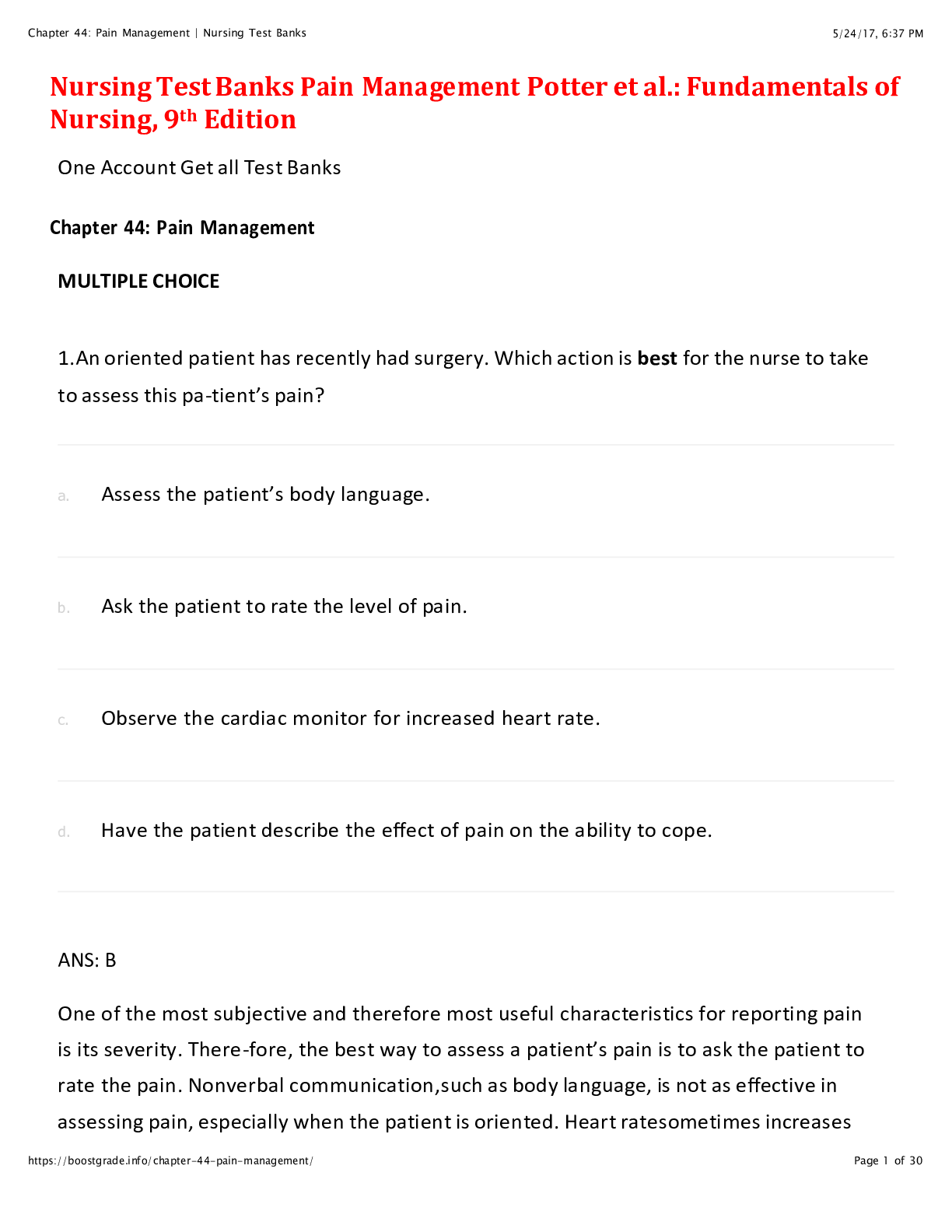
Reviews( 0 )
Document information
Connected school, study & course
About the document
Uploaded On
Nov 12, 2021
Number of pages
59
Written in
Additional information
This document has been written for:
Uploaded
Nov 12, 2021
Downloads
0
Views
27

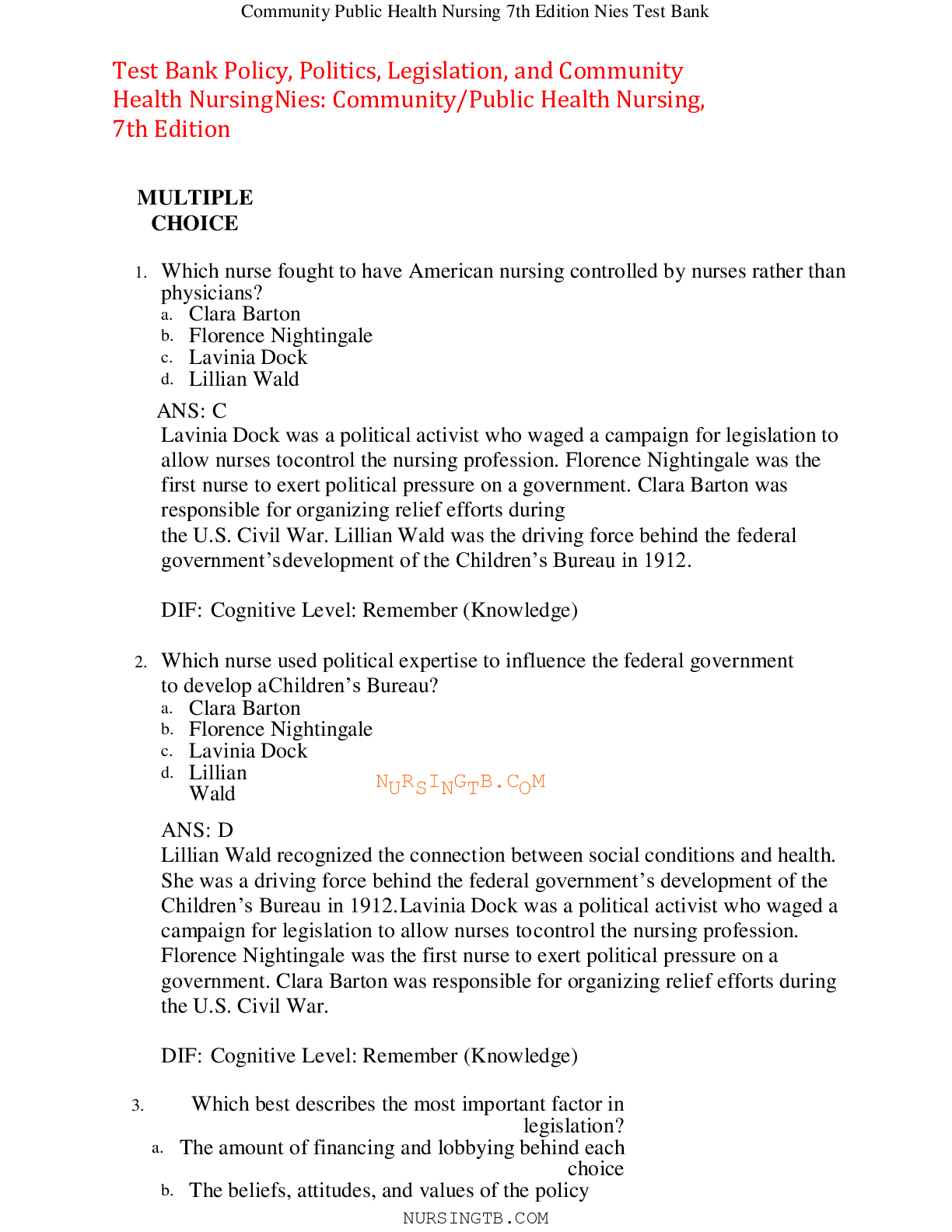


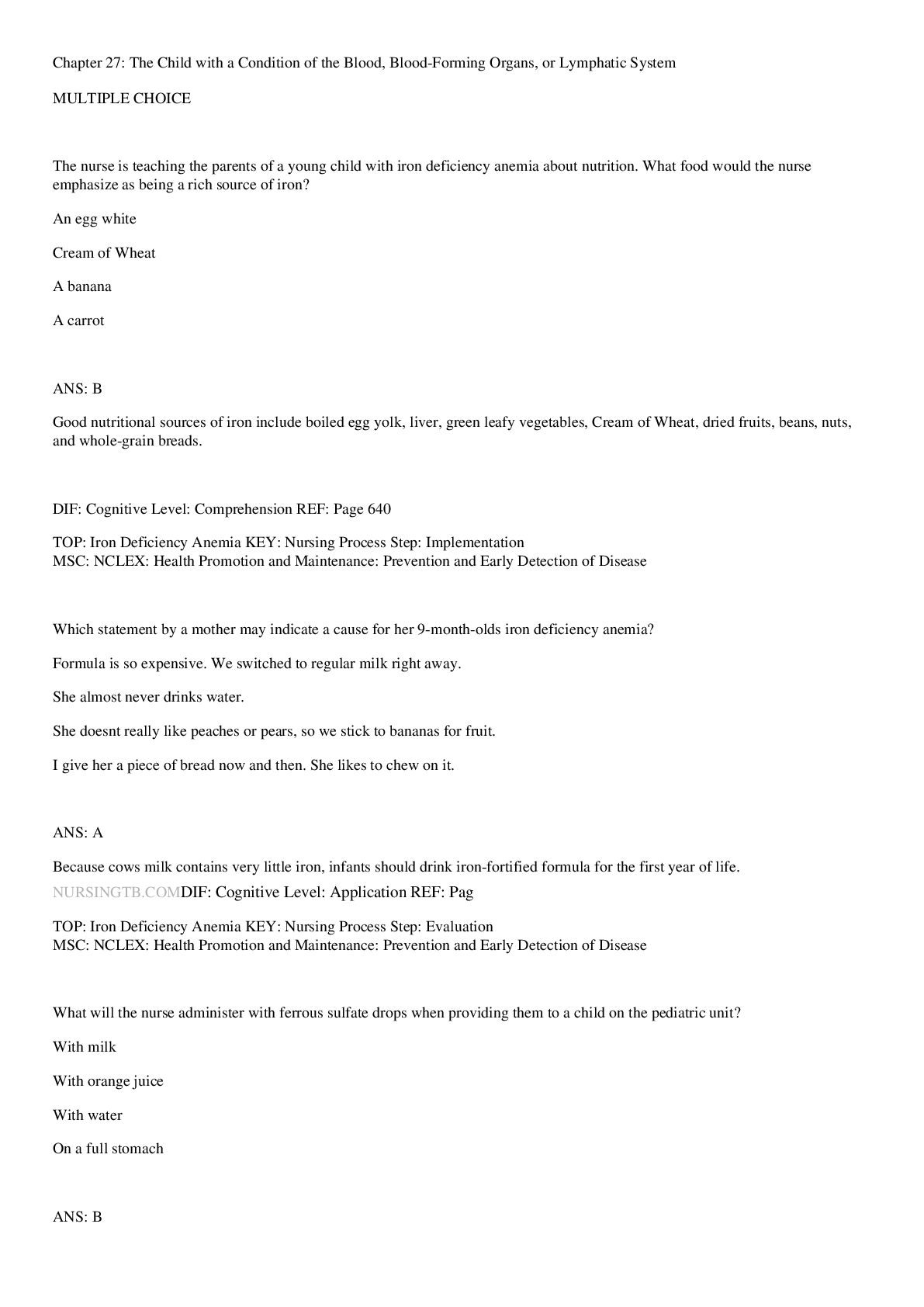



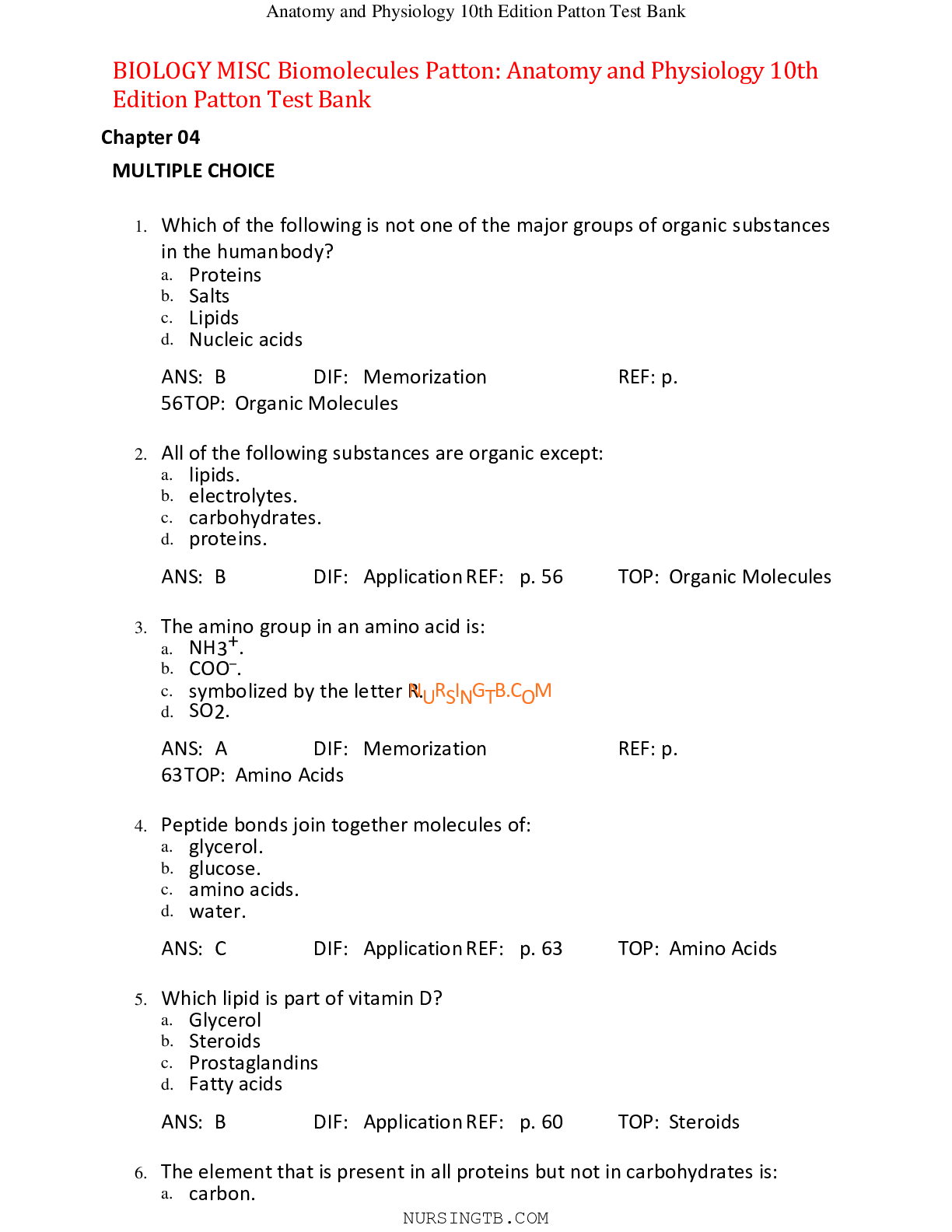







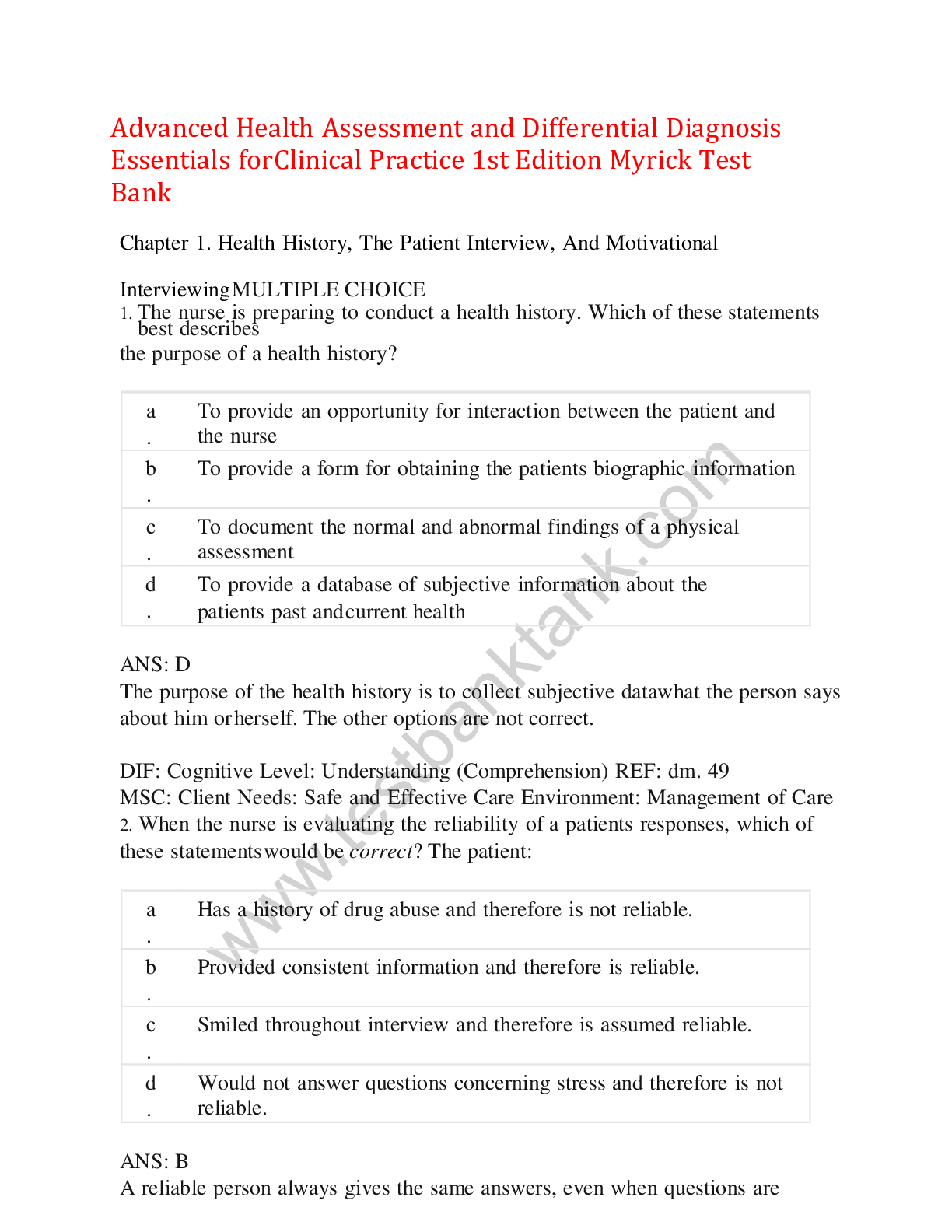



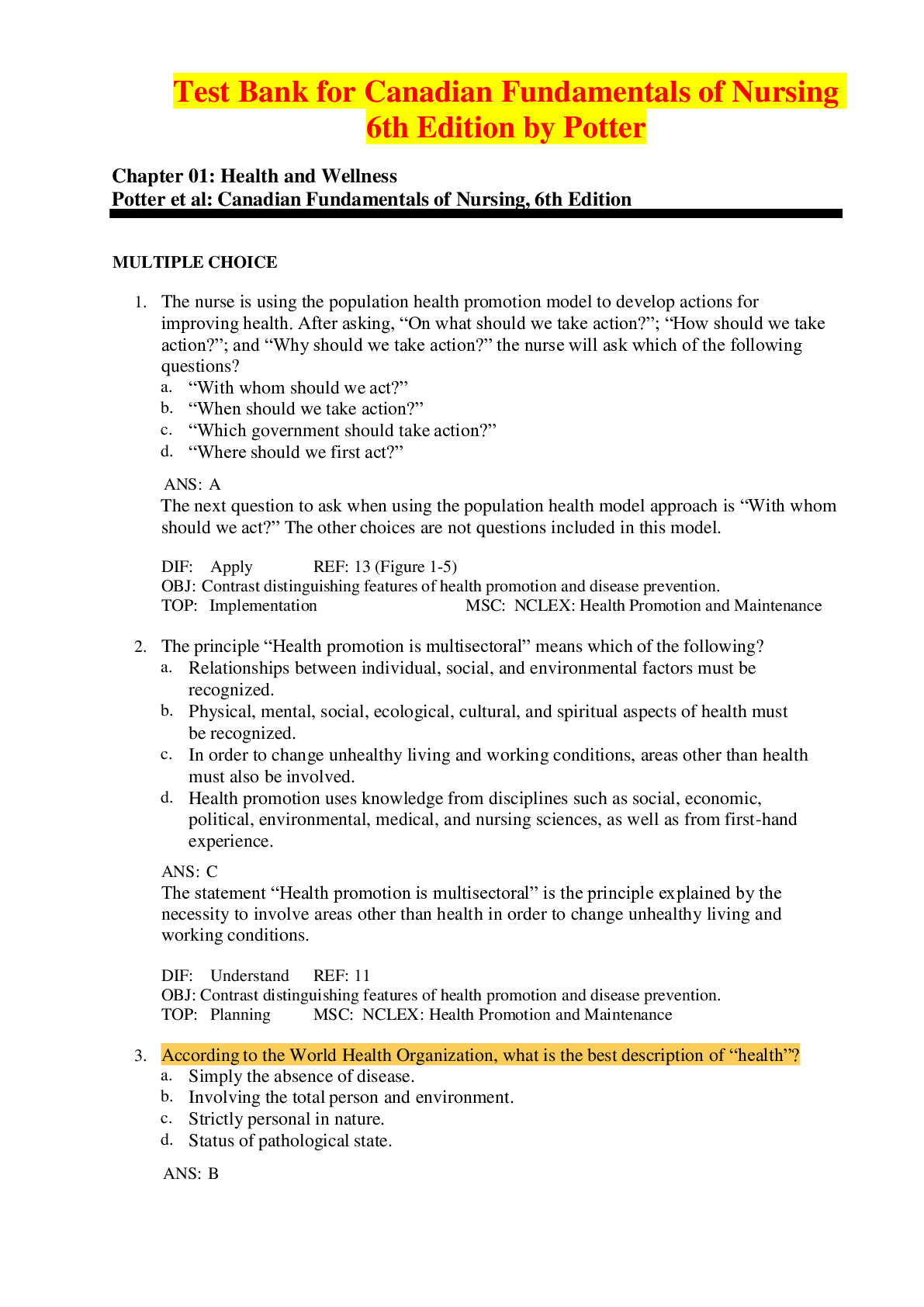


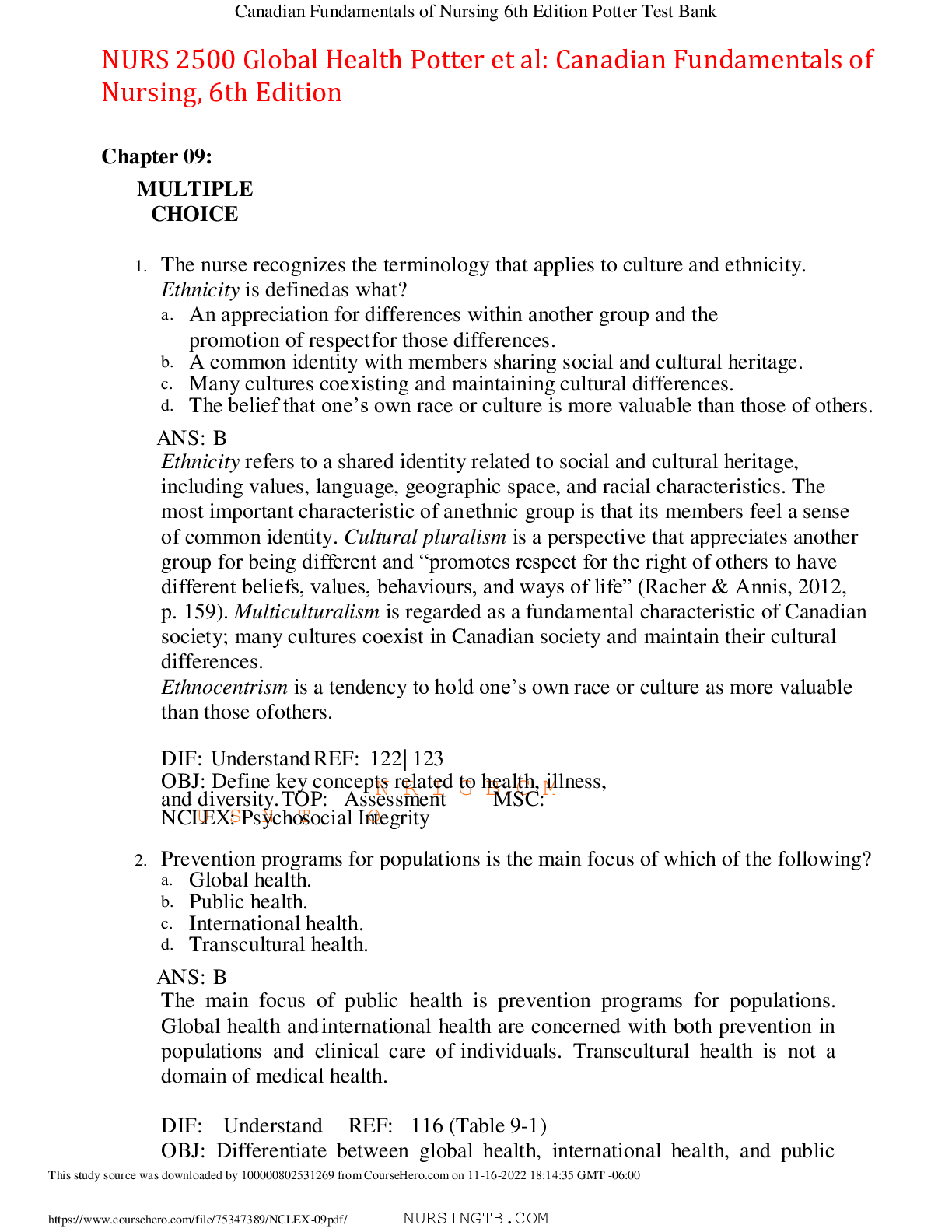
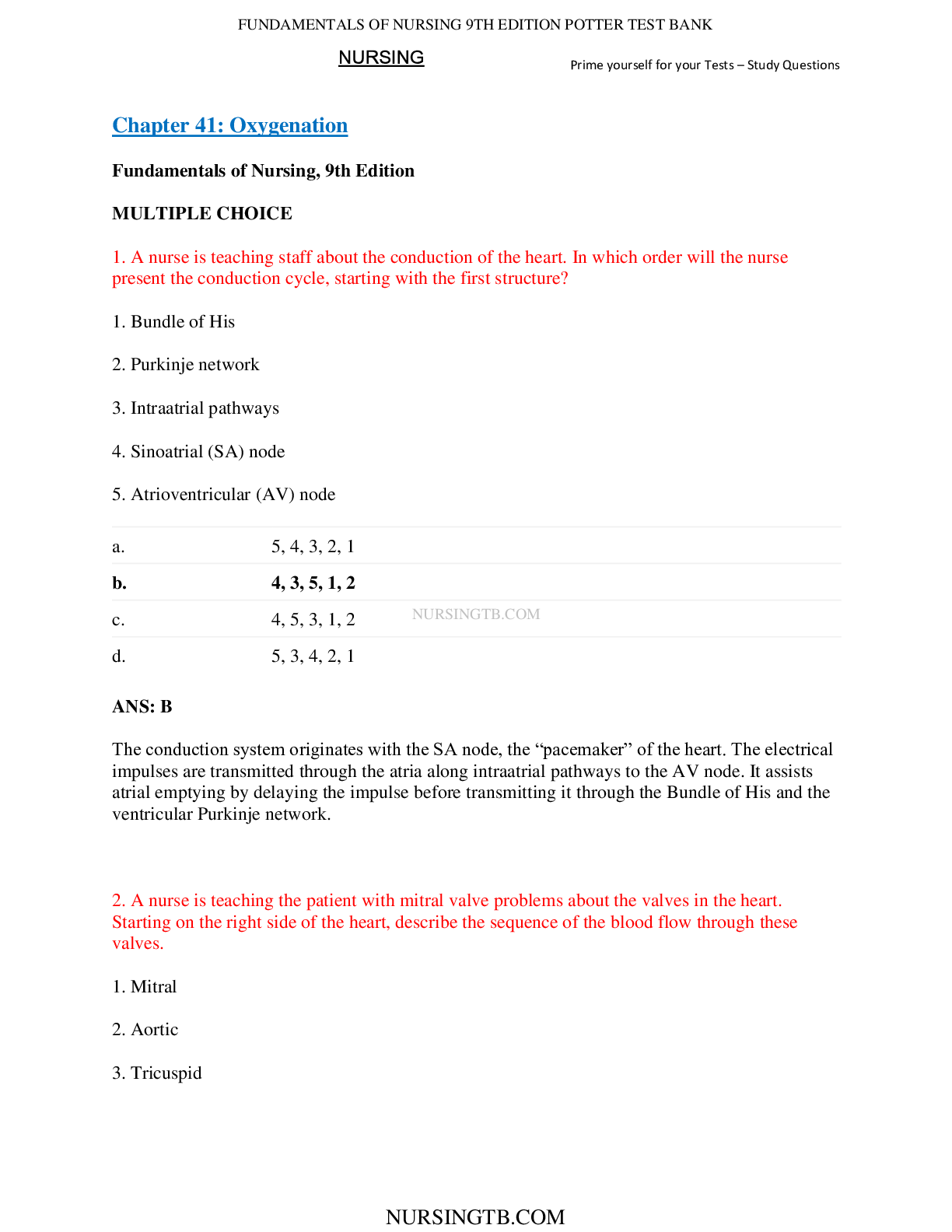

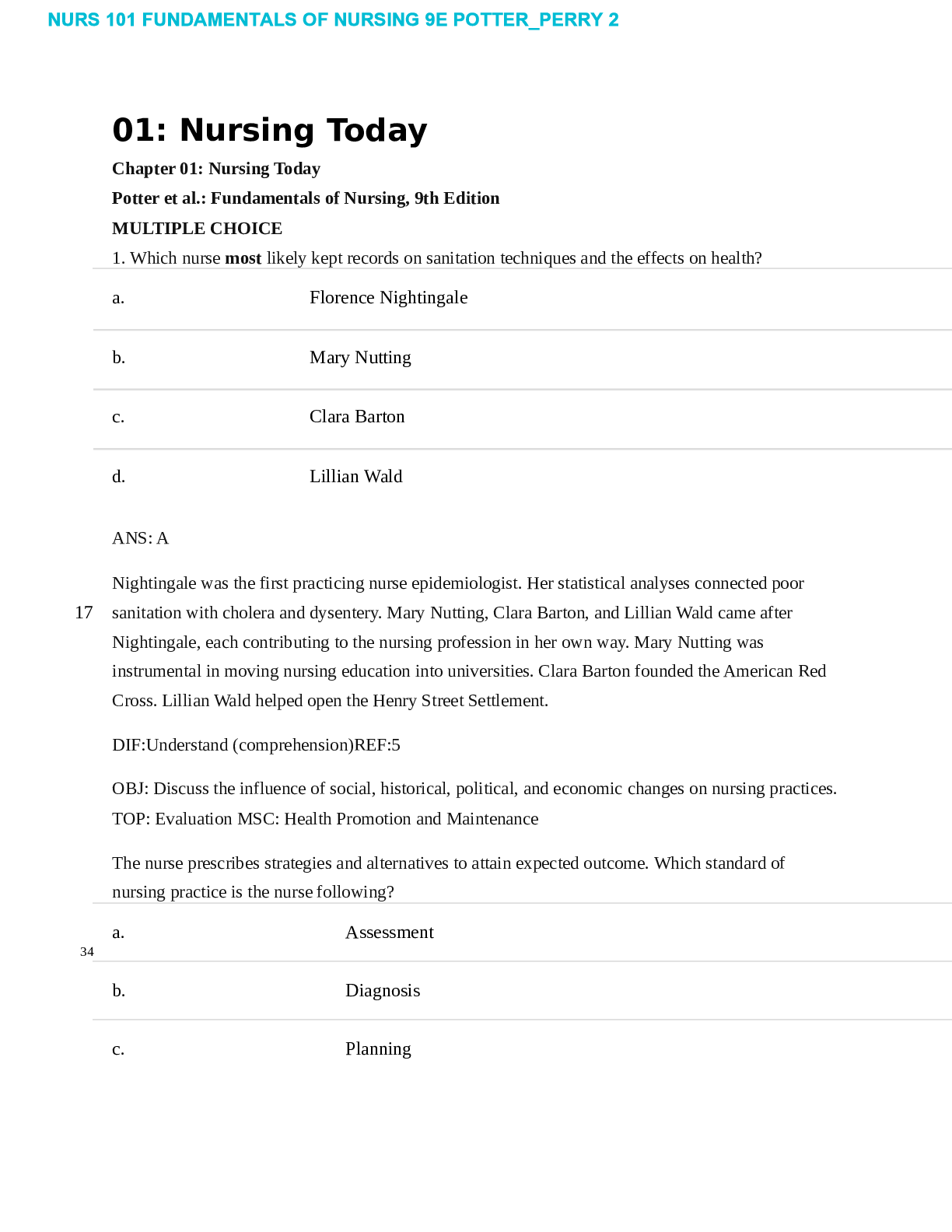
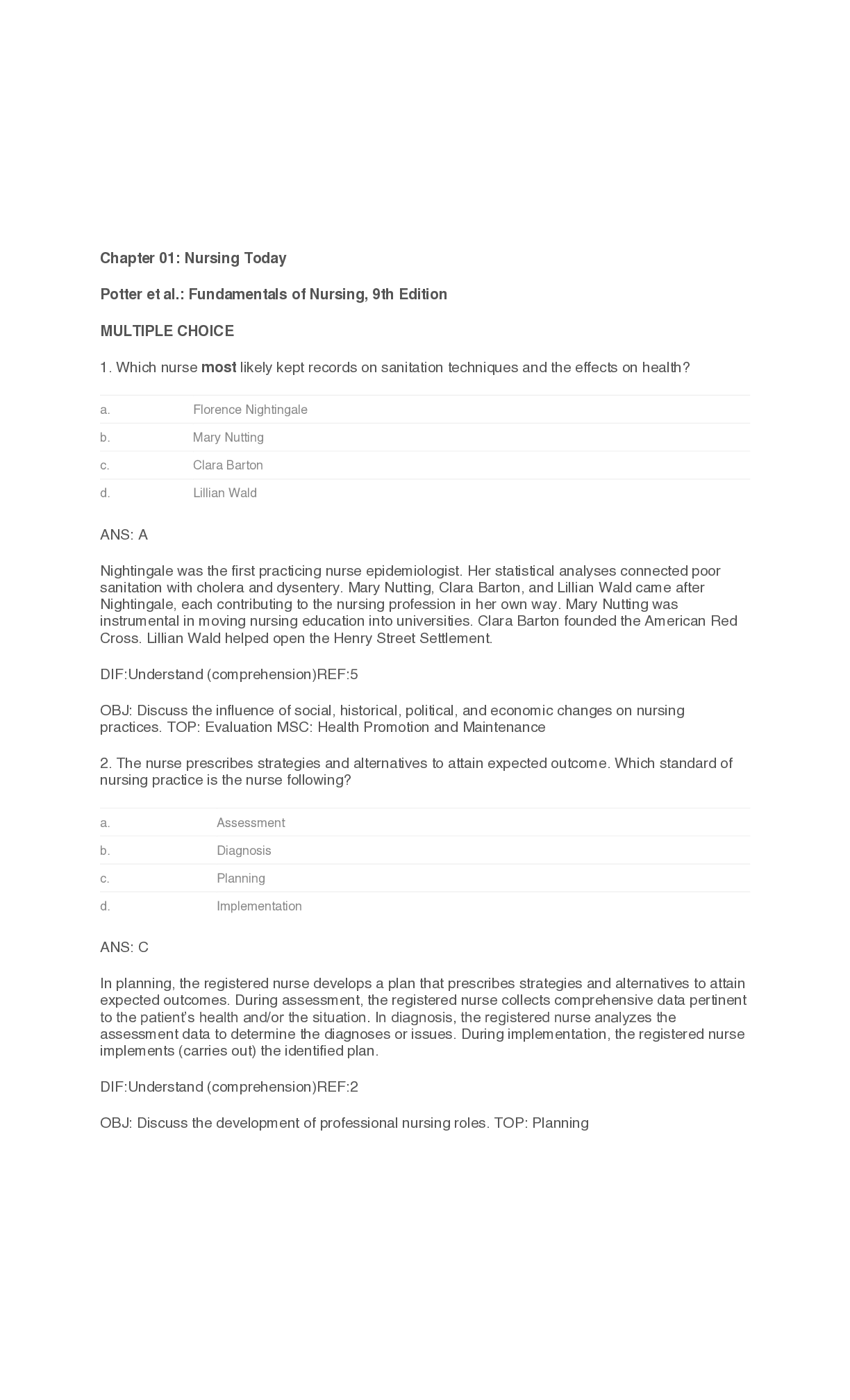


 A+ guide.png)
